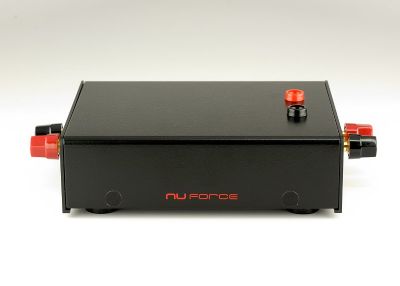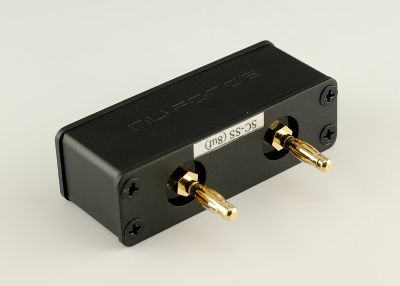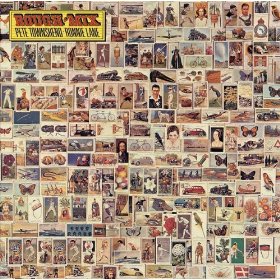NuForce Magic Cube
| NuForce Magic Cube |
| The Spintronic Thaumaturge |
|
|
|
April 2010 |

Okay, I know how this looks, i.e., here we have yet another “magic-box” type of product purported to magically improve the sound of our audio systems when inserted in the signal path of our “purist” audio systems (specifically, between the amplifier and the speakers). While this would seem counterintuitive and counterproductive to some, I believe the NuForce Magic Cubes will find their way into many audiophile systems simply because they improve the sound.
Each Magic Cube contains a patent-pending Smith Cell under license from Robert “Bob” Smith, former head of SP Technology and current head of Aether Audio. Bob Smith is the inventor/designer of the Smith Cell and markets a more expensive version dubbed the “Black Box,” assembled entirely by hand with pricey premium quality parts, wiring, and connectors under the Aether Audio moniker. This makes the price of the Black Box more than 3x that of the $498/pair Magic Cubes. I have not tried the Aether Audio Black Boxes, so I can only offer my experience with the NuForce Magic Cubes.
The Smith Cell itself is a passive device that has its roots in a branch of physics called Spintronics that deals with the behavior of quantum particles in conductive metals. Bob Smith himself tried to explain the concept to me and also sent me some written primers on the subject. Take my word for it, the exact working mechanism of the Smith Cell is not the easiest concept to grasp and is probably best thought of as “magic” for those who are not geniuses or actual quantum physicists.
Be that as it may, we mere mortals can certainly reap the very real sonic improvements imparted by Smith Cells by merely buying a pair of NuForce Magic Cubes and installing them between our amplifiers and speakers.

Optional Filters: NuForce also offers optional plug-in filters that work in concert with the Magic Cubes. The filters are supposed to reduce distortion and ringing by canceling the electrical force that pushes back from the speaker to the amplifier. NuForce’s Jason Lim feels that the filters don’t offer much improvement with NuForce amplifiers, and in my experience, I didn’t hear much difference using the filters with my Wyred 4 Sound amplifier. That said, the filters may work better with other amplifiers. NuForce offers filters for different types of solid-state and tube amplifiers that in some cases (depending on the amplifier’s design) will alter the character of the sound for the better. It may be best to consult the folks at NuForce to ask if the filters would be helpful with your particular amplifier and speakers. In any case they are inexpensive to try at under $50 per filter.
Insertion
My system uses the Wyred 4 Sound STI-500 amplifier, My Audio Cables CuQ speaker cables, and the NSR Sonata D3 speakers.
My main curiosity in doing this review stemmed from changes in sonic performance I notice when changing out the various audio cables in my system. The Magic Cube is alleged to rectify phase errors resulting from the electric signal passing through many dissimilar metals between your amplifier’s output wiring, connectors, different solders and types of conductive wire that eventually connect to your speaker drivers. It is also claimed to reduce noise (noise that rides in on the AC signal that is not entirely filtered out before going to the speakers), improve low-level micro-dynamics, and enhance spatial relationships in the soundstage.
Before installing the Magic Cubes, I experimented for days to get the best performance from my system cabling, trying virtually every possible combination of different manufacturer’s wires that I had on hand.
Installing the Magic Cubes is easy as pie, thanks to NuForce’s use of 5-way binding posts for both inputs and outputs, and their inclusion of a meter length of heavy-gauge pure copper speaker cable with banana plugs on both ends. I had them installed in my reference system in minutes and was ready to crank my tunes and evaluate the results.
Let ‘er wail
My first test of the Magic Cubes was listening to vinyl recordings I had just played without the arcane cubes. I recall that there was a change in timbre, especially in the upper midrange and highs. The highs had more detail and seemed more extended and the soundstage had more bloom to it. I wasn’t entirely convinced that I liked this new presentation better but it was interesting. I decided to put more break-in time on the Magic Cubes before making any judgments.
 A couple of days later I bought a new CD (En Concert; Brushfire B0012973-02) from one of my favorite singer-songwriters, Jack Johnson. My first selection was “Belle/Banana Pancakes,” that begins with applause, ambience, whistles, and general noise from the frisky French crowd, hinting at a spacious venue. When the band chimed in and I heard the first words and guitar cords, I knew I was in for a treat.
A couple of days later I bought a new CD (En Concert; Brushfire B0012973-02) from one of my favorite singer-songwriters, Jack Johnson. My first selection was “Belle/Banana Pancakes,” that begins with applause, ambience, whistles, and general noise from the frisky French crowd, hinting at a spacious venue. When the band chimed in and I heard the first words and guitar cords, I knew I was in for a treat.
The sound of the band when it all kicked in was HUGE and more dynamic than I thought possible. The soundstage was wall-to-wall-to-ceiling immense and there I sat, in the middle of all of it. And so Jack played on, song after song, and I had never heard my system sound that good before. I recall e-mailing one of my friends afterwards and telling him that either the Magic Cubes were working great or Jack Johnson’s En Concert CD must qualify as the best live pop music recording of all time.
For a couple of weeks after that, I played through my favorite CD’s generally marveling at the “rightness” of the sound, and the incredible dynamic contrasts and improved soundstaging.
Then I received a new component for evaluation (my next review). It was the new ZYX 4D-G moving coil cartridge that lists for roughly 5 G’s here in the US of A. Of course I had to immediately shove that bad boy into my trusty Michell turntable and lower the ZYX to the spiraling groove below.
 When the first guitar licks snapped out from “My Baby Gives it Away” on Pete Townshend and Ronnie Lane’s Rough Mix (MCA-2295), I knew I was in for a treat. I’d never heard any cartridge sound so utterly transparent, focused, and smooth before. Next I played my “Modern Music” album (Harvest ST-11575) recorded circa 1976 by Be Bop Deluxe and I had to marvel at how the ZYX kept the vocals, guitars, and other instruments from all jumbling together as they sometimes do with lesser phono playback gear.
When the first guitar licks snapped out from “My Baby Gives it Away” on Pete Townshend and Ronnie Lane’s Rough Mix (MCA-2295), I knew I was in for a treat. I’d never heard any cartridge sound so utterly transparent, focused, and smooth before. Next I played my “Modern Music” album (Harvest ST-11575) recorded circa 1976 by Be Bop Deluxe and I had to marvel at how the ZYX kept the vocals, guitars, and other instruments from all jumbling together as they sometimes do with lesser phono playback gear.
And so I played on, record after record, and witnessed the same wide dynamic envelope and spacious soundstaging that I had been hearing from my CD’s. I also noticed that I could clearly hear almost every word on most of my recordings… even if I was in the next room on the computer writing something like this article.
Withdrawal
One day, I began thinking “My system sounded great before I installed the Magic Cubes—maybe the improvements are all in my head.”
So I removed the Magic Cubes and hooked my MAC speaker cables back directly to the speakers and began to listen. At first I thought that my system sounded almost the same without the Magic Cubes. Dynamics were still smashing, transients were sharp and clear, the bass was articulate and punchy and the soundstage was reasonably spacious.
But a half a day later, playing through different recordings the reality began to sink in. My system had definitely lost some of its magic. Certain sounds were more biting and grating, guitars had lost some of their harmonic sweetness, and there was more interstitial noise clouding the soundstage.
I put on the aforementioned Townshend-Lane Rough Mix record and thought “this sounds pretty good, but the soundstage seems a bit flat…” So back in went the Magic Cubes.
To my amazement, the transparency of the vocals and instruments snapped back into focus. Both the guitars and vocals were rendered with lifelike presence and the soundstage grew deeper. “Oh yeah,” I said to myself—“now that’s how it’s supposed to sound!”
Conclusion
For those of you who are still thinking that the NuForce Magic Cube is just another audiophile gimmick, my suggestion is “put up or shut up!” Just try the Magic Cubes in your system and return them within 30 days for a full refund if you’re not pelased with them. NuForce’s Jason Lim asserts that “the suggested method for evaluating the Magic Cube is to let it play in the system for a week and then remove it to hear what’s missing. The Magic Cube improves the system in many subtle ways that are hard to pin point initially.”
Lim also offered that the Magic Cubes are most effective in less expensive systems using average components and lower cost wiring, and those without decent AC power filtering. I wouldn’t categorize my reference system as a typical low-cost audiophile system, and yet I still felt the pain of withdrawal when I removed the Magic Cubes. I had to put them back in the system the very next day and guess what… The magic returned!
In my opinion the NuForce Magic Cube is a very worthwhile accessory. Highly recommended!
Manufacturer
Nuforce, Inc.
382 South Abbott Ave
Milpitas, CA 95035
Web: www.nuforce.com
Email: salesteam@nuforce.com
Online Store Email: directsales@nuforce.com
Primary phone: +1-408-890-6840
Secondary phone: +1-408-262-6777
Fax: 1-408-262-6877
Skype Id: nuforce-sales
Description
Magic Cube
Price: $249 each
Optional plug-in filters
Price: $49.95 each
30-day Trial
Warranty: 3 years after trial period
![]()
Don’t forget to bookmark us! (CTRL-SHFT-D)
Stereo Times Masthead
Publisher/Founder
Clement Perry
Editor
Dave Thomas
Senior Editors
Frank Alles, Mike Girardi, Russell Lichter, Terry London, Moreno Mitchell, Paul Szabady, Bill Wells, Mike Wright, and Stephen Yan,
Current Contributors
David Abramson, Tim Barrall, Dave Allison, Ron Cook, Lewis Dardick, John Hoffman, Dan Secula, Don Shaulis, Greg Simmons, Eric Teh, Greg Voth, Richard Willie, Ed Van Winkle, Rob Dockery, Richard Doran, and Daveed Turek
Site Management Clement Perry
Ad Designer: Martin Perry





Be the first to comment on: NuForce Magic Cube